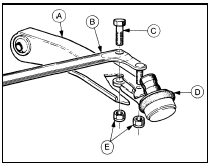Front suspension lower arm (pressed steel type) - removal, overhaul and refitting
1 The pressed steel type suspension is only fitted to pre-May 1983 1.1 litre models (see illustration).

4.1 Pressed steel type lower arm components
A Lower arm
B Tie-bar
C Retaining bolt
D Balljoint
E Retaining nuts
Removal
2 Jack up the front of the car and support it
on stands (see “Jacking and Vehicle Support”).
3 Undo the nut and remove the pivot bolt securing the lower arm at its inboard end.
4 Undo the two nuts which secure the tie-bar and lower arm balljoint to the lower arm.
Separate the arm from the tie-bar and remove it from under the car.
Overhaul
5 Renewal of the pivot bush is carried out in
the same way as described in Section 3.
6 If the balljoint is worn it can be renewed after removing it from the hub carrier as described in Section 3.
Refitting
7 Refitting is the reverse sequence to
removal. Tighten all nuts and bolts to the
specified torque with the weight of the car on
its roadwheels. If the balljoint has been
removed, refit the Torx pinch-bolt with its
head towards the rear of the car.
See also:
Alternator - removal and refitting
Removal
1 Disconnect the battery leads.
2 Disconnect the multi-plug, or disconnect
the wires from their terminals on the rear of
the alternator, noting their locations (as
applicable), then slack ...
OHV and HCS engines
The 1.1 litre and 1.3 litre OHV engines are of four-cylinder,
in-line overhead valve type (hence OHV), mounted transversely together with the
transmission, at the front of the car.
The crankshaft ...
General information
OHV engines
The 1.1 litre and 1.3 litre OHV engines are
of four-cylinder, in-line overhead valve type
(hence OHV), mounted transversely together
with the transmission, at the front of the car.
Th ...
